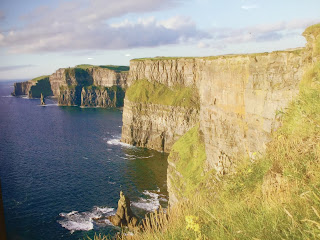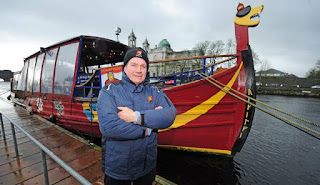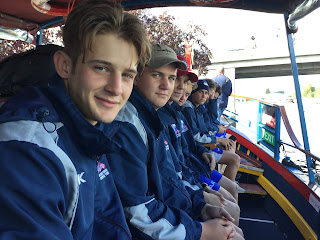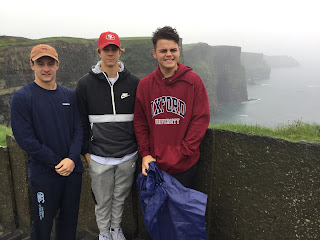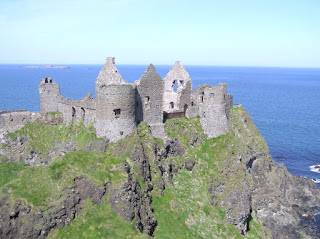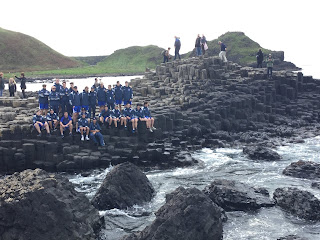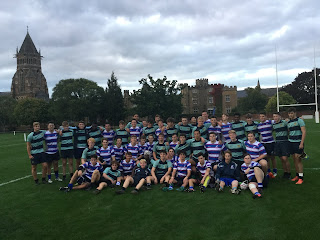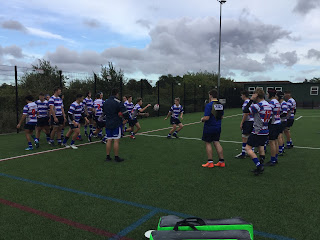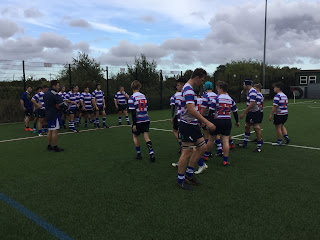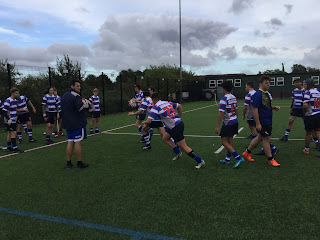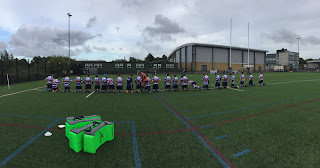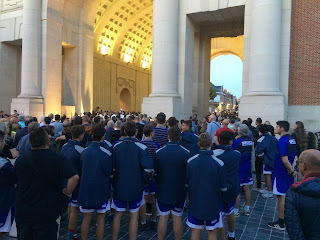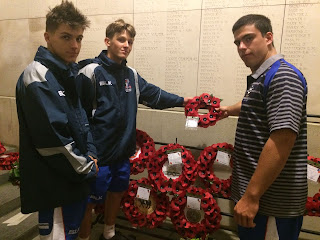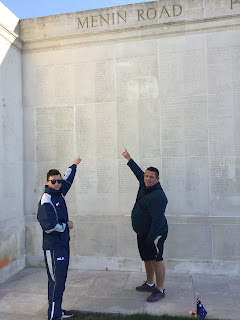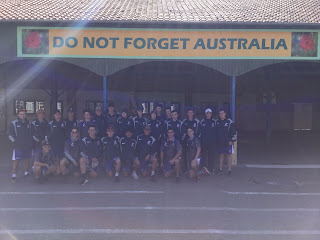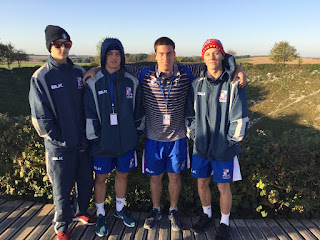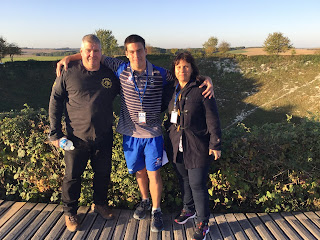Monday, 30 September 2019
PHOTO GALLERY
A photo gallery has been created here if you want to view or download any photos from the tour. This will be updated during the tour.
Day 11 and 12 - Galway
After leaving Dublin we started our journey towards Galway in the West of Ireland. Our first stop was the city of Althlone; located on the River Shannon near the southern shore of Lough Ree. We took a Viking Ship cruise on the River Shannon with our Captain Viking Mike and his crew to Clonmacnois where the Vikings arrived in 842. The site at Clonmacnois includes the ruins of a cathedral, seven churches (10th -13th century), two round towers, three high crosses and the largest collection of Early Christian graveslabs in Western Europe. The rest of the day was spent travelling to Galway where we would stay for the next two days in preparation for the game against Garbally College.
The next day brought with it a large amount of rain. This did not stop us, however, from visiting The Cliffs of Moher; Ireland's most famous tourist attraction. Despite the weather the view was worth battling the elements.
The next day brought with it a large amount of rain. This did not stop us, however, from visiting The Cliffs of Moher; Ireland's most famous tourist attraction. Despite the weather the view was worth battling the elements.
Sunday, 29 September 2019
Game 3 - Catholic University School
Game 3 versus Catholic University School
28 September 2019
Back to our old mates in Dublin, we have been hosted by CUS
since the original tour in 2003 and had the opportunity to host them in
Townsville in 2012. Knowing fore well that very game in Dublin is going to be a
torrid affair coaching staff tried to prepare the team for a tough and gritty
game of rugby. With injuries starting to creep into the squad and sickness
levelling others our depth was challenged.
Losing the toss, IPC was forced to run up hill and against a
strong breeze in the first half – something they struggled with, starting very
sluggishly. IPC, while not lacking effort across the field, failed to fall into
their shape and were stalled at the breakdown on several occasions, giving away
soft turnovers due to lack of support. This was also couple with not getting
off the line quick enough and maintaining their spacing in the defensive line.
With the wind at
their backs, CUS capitalised on our mistakes and soon ran in a try which was
quickly answered by IPC with one of their own before the half time break.
Fighting hard to gain field position against the wind IPC consistently made it
hard for themselves by turning the ball over once they had made inroads into
CUS territory – only to be punished with the ball being put in behind them on a
regular basis.
Half time saw IPC down 7 to 5 and with the lads looking for
some guidance from the coaches. Aware of what they needed to do the team was
simply guided at half time to weather the storm and ensure that our support and
breakdown work was far more aggressive than what it had been in the first half.
The second half saw IPC begin to dominate possession but still not take
advantage of the wind at their backs. Making it hard work and with CUS willing
to mix it up IPC scored another converted try along with CUS who scored one of
their own.
With only a couple of minutes left on the clock and with CUS
leading 14 to 12 IPC needed to stick to their guns and trust in the systems and
their mates on the field. Banging a long kick into the corner IPC managed to
string several phases together before gaining a scrum on the opposition’s 22m.
Winning the scrum the forwards went to work, taking the ball up the middle
until it was finally released to the backs who scored a final and game winning
try in the right hand corner – IPC eventual victors, 17 to 14.
Tries: Nic Pearce, Asher Guy and Jack Kirkpatrick.
Conversions: Nic Pearce (1)
MVP’s: (3) Asher Guy – (2) Zac Thomson – (1) Terrence Rooney
Days 9 and 10 - DUBLIN
We woke up on Day 9 and headed to Dunlace Castle, built by the early Scots in the 1500's. It was then on the road to Dublin where the boys were billeted for 2 nights. While in Dublin IPC played Catholic Universtiy School (CUS), a private school for boys. A school that IPC Rugby has hosted in the past in Townsville and which we have a special relationship with - having been hosted by them for every tour since 2003. Under the custodianship of the Marist Fathers, the school has educated Irish politicians, leading academic and literary figures, and 3 Olympic Gold medalists. Thank you very much to those Dublin families who welcomed IPC boys into their lives. Hopefully, some life time relationships were established.
Day 8 - BELFAST
The next morning we were up and on by the bus by 5am for the drive to Birmingham Airport to catch a flight to Belfast. After saying goodye to Joe, who had been our bus driver for the past week we boarded the plane and touched down in Belfast less than 1 hour later. So far on our trip we had been blessed with great weather and Belfast was no different. We jumped on a new coach and headed off to the Titanic Experience by the old ports of Belfast where the Titanic had been built and left for its maiden voyage. I think we all know how that one ended up. The museum was amazing and provided a great insight into the past. It was then off to the Giant's Causeway;an area of about 40,000 interlocking basalt columns.
Next was a walk down to Carrick a Rede rope bridge; a bridge suspended almost 100 ft (30 m) above sea level, the rope bridge was first erected by salmon fisherman 350 years ago. After a couple of long walks we were all tired and were very grateful for the lovely homecooked meal we received that night at the Hostel.
Next was a walk down to Carrick a Rede rope bridge; a bridge suspended almost 100 ft (30 m) above sea level, the rope bridge was first erected by salmon fisherman 350 years ago. After a couple of long walks we were all tired and were very grateful for the lovely homecooked meal we received that night at the Hostel.
Game 2 - RUGBY SCHOOL
Game 2 versus Rugby School
25 September 2019
Excited about being in the birth place of Rugby Union, let
alone playing on the hallowed ground of where Webster Ellis picked up the pig
skin soccer ball and ran to invent Rugby was always going to be special. Rugby
School only allow their 1st XV team to play on the ‘Close’, so to
play on this world famous field was a real opportunity for the boys.
After a good outing in their first game the boys were raring
to go in their second hit out. Playing the Rugby School seconds and thirds
combined we all expected a tough match. After initially starting well and
starving Rugby of the ball we ran in two quick tries. It looked like it could
be all one way traffic as the boys were playing very well up the middle. IPC
scored another good try which was very quickly answered with a try to Rugby
just before half time. IPC went into the break with a well deserved lead of 17
to 5.
However, Rugby came out in the second half with some extra
intensity and momentum shifted quickly as they began to get into their stride.
This change in intensity had IPC scrambling and before long the score board was
locked up at 17 all. IPC did not start the second half well with ill discipline
costing them valuable field position and Rugby’s exceptionally quick winger to
run in three unanswered tries. Feeling the shift in momentum IPC had to make a
decision to dig in and fight it out. Deciding to square up and do the work
inside before going outside, it wasn’t long before IPC gained the ascendancy again.
Rallying as a team the boys ran in five to Rugby’s three tries in the second
half to become eventual winners 52 to 24 in a very gritty performance.
Tries: Terrence Rooney, Lachlan Ryan, Zac Thomson (2), Harrison Keir (2), Darcy
Walters and
Jack Kirkpatrick.
Conversions: Declan Marchioni (5) and Nic
Conversions: Declan Marchioni (5) and Nic
MVP’s: (3) Asher Guy – (2) Harri Keir – (1) Lachlan Ryan
Day 5 - 7 - RUGBY
After the first game against Langston the boys spent another night with their Canerbury billets. The next morning we were back on the bus and travelled 3 hours to Bedford where we had lunch at Bedford College. Another 2 hours on the road and we arrived at Rugby, the birthplace of the game they play in Heaven.
It was only fitting that the first place we visited was the Rugby Hall of Fame where the boys were able to experience a variety of displays and multimedia experiences about the history of Rugby Union and some of the great players and teams throughout the years.
After a good night sleep we travelled to Stratford Upon Avon and the boys spent some time exploring the birthplace of some guy called William Shakespeare. It was then off to the Rugby school for a quick tour of the school. The boys were ready for Game 2 against Rugby and the chance to play on their number 1 field.
It was only fitting that the first place we visited was the Rugby Hall of Fame where the boys were able to experience a variety of displays and multimedia experiences about the history of Rugby Union and some of the great players and teams throughout the years.
After a good night sleep we travelled to Stratford Upon Avon and the boys spent some time exploring the birthplace of some guy called William Shakespeare. It was then off to the Rugby school for a quick tour of the school. The boys were ready for Game 2 against Rugby and the chance to play on their number 1 field.
Thursday, 26 September 2019
GAME 1 - LANGTON SCHOOL
23 September 2019
Having had a great start to the tour the boys were very keen
to get on the paddock and have a good hit out. Playing on a very impressive
synthetic 4G field we were blessed with fine weather, for at least the majority
of the game.
Receiving the kick off we managed to make a meal of it which
resulted in a scrum to Langton on the 20m line – result, grubber kick and down
seven nil due to the resulting converted try. Poor start but a chance to
regroup and put this behind us. Matching it well up front and willing to throw
the ball around both sides played some exciting and expansive rugby. While IPC
was doing well by trusting their systems and defending well we were not
protecting our own ball at the breakdown causing us to turn the ball over on
several occasions cheaply.
These cheap turnovers made the boys work extremely hard to
weather the storm but at the same time made them sit up and assess the
situation. Realising what needed to be done IPC shortened up their support
lines and accuracy at the attacking breakdown and began to make large inroads
into Langton’s defence. Having adapted well the boys managed to dominate field
position and came away at half time in front by two tries, Ethan Woods and
Terrence Rooney, to one.
Starting the second half well, IPC found themselves up
against a new look Langton team which was prepared to shift the ball from edge
to edge to challenge our defence and really put us under the pump, having to
scramble in defence on several occasions. Another challenge was just around the
corner with the weather deciding to test the skills of the Townsville lads and
challenge them it did.
With the wet weather came the call from coaching staff to
tighten it up and be direct, something that did not happen straight away. Still
playing as if it was a bright sunny day, IPC backed themselves out wide which
resulted in a number of more than pleasing outcomes. While there were moments
that were quite comical the boys worked extremely hard and ran in an additional
three tries to two in the second stanza to come away eventual winners 31 to 21.
Tries: Ethan Woods, Terrence Rooney, Zac Thomson, Darcy
Walters and Harrison Keir.
Conversions: Nic Pearce (6)
MVP’s: (3) Zac Thomson – (2) Ethan Woods – (1) Harri Keir
Day 4 - ARRIVE IN DOVER
The ferry ride to England gave the boys the chance to view the White Cliffs of Dover.
 |
| Arrival in England. In front of the White Cliffs of Dover |
It was then off to The Simon Langton Grammar for Boys in Canterbury where the boys were billeted out for the next 2 nights. The boys had a great experience seeing how some English families lived. Two of the boys even stayed with a Formula 1 Engineer and an International fashion designer. The staff also had a good night with Nicky Little, an International Rugby player from Fiji, but that's a story for another time.
 |
Contemplating life by the North Sea |
The next morning we did some sightseeing so that the boys could have a relaxing time before their first game. We first visited the seaside town of Whistable and then it was off to Langton school for the tour's first game.
Day 4 - BATTLEFIELD TOUR AND OFF TO ENGLAND
On our fourth day we met our second tour guide Filip, a local secondary school History teacher. Not only did he have a great sense of humour, his knowledge of the places we visited was outstanding. He entertained the boys with some great stories and there wasn't a question he could not answer.
We started our tour at Hill 60; an area of ground which remains relatively undisturbed since the end of the Great War. During the Great War there was fierce fighting here, and the hill changed hands between the Germans and the Allies several times. Both sides also dug tunnels and planted mines underneath the hill. Because of this, the remains of many soldiers from both the Allied and German forces still lie here.
The next stop was Langemark cemetary. Unlike the previous cemetaries we had visited, Langemark was a German cemetary. The contrast of the German memorial to the Commonwealth ones that we had visited in the past days was chalk and cheese. Massive Oak trees surrounding the memorial blocked out any sun trying to get in. Where the Commonwealth headstones were white the German ones were dark and moody. The most outstanding feature, however, was that unlike Commonwealth plots where every soldier was given an individual burial and headstone, the German soldiers were buried 5-6 to a plot. In one area 25000 Germans had been buried together as comrades in the same grave.
The contrast was even more prominent when we visited our next stop; Tyne Cot cemetery. Tyne Cot is the largest Commonwealth War Graves Commission cemetery in the world. It is now the resting place of more than 11,900 servicemen of the British Empire from the First World War. There were two Townsville soldiers that we located and Tour Captain Zac Thomson led the group in reciting the 'Ode of Remembrance' over their final resting places.
Our final stop in Belguim was Polygon Wood; a large wood which was completely devastated in the First World War. The wood was cleared by Commonwealth troops at the end of October 1914, given up on 3 May 1915, taken again at the end of September 1917 by Australian troops. Polygon Wood was a picturesque cemetery surrounded by beautiful countryside and manned by a lone Donkey called Tomanky.
The boys presented Fillip with a IPC Rugby tie to thank him for his time and wealth of knowledge and we got back on the bus and made our way to the ferry to take us across the English Channel to the 'Motherland'.
We started our tour at Hill 60; an area of ground which remains relatively undisturbed since the end of the Great War. During the Great War there was fierce fighting here, and the hill changed hands between the Germans and the Allies several times. Both sides also dug tunnels and planted mines underneath the hill. Because of this, the remains of many soldiers from both the Allied and German forces still lie here.
The next stop was Langemark cemetary. Unlike the previous cemetaries we had visited, Langemark was a German cemetary. The contrast of the German memorial to the Commonwealth ones that we had visited in the past days was chalk and cheese. Massive Oak trees surrounding the memorial blocked out any sun trying to get in. Where the Commonwealth headstones were white the German ones were dark and moody. The most outstanding feature, however, was that unlike Commonwealth plots where every soldier was given an individual burial and headstone, the German soldiers were buried 5-6 to a plot. In one area 25000 Germans had been buried together as comrades in the same grave.
The contrast was even more prominent when we visited our next stop; Tyne Cot cemetery. Tyne Cot is the largest Commonwealth War Graves Commission cemetery in the world. It is now the resting place of more than 11,900 servicemen of the British Empire from the First World War. There were two Townsville soldiers that we located and Tour Captain Zac Thomson led the group in reciting the 'Ode of Remembrance' over their final resting places.
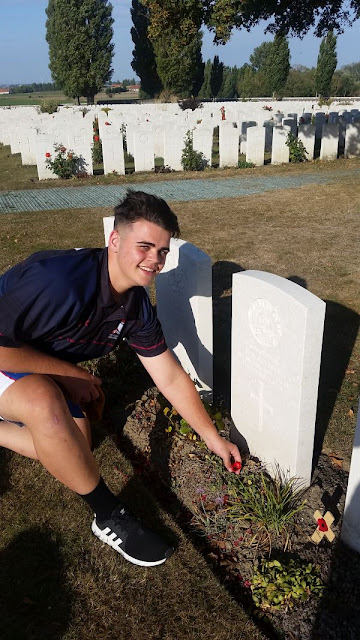 |
| Terrence Rooney laying a poppy at the Headstone of Private P.B Rooney 31st BTN Australian Infantry |
The boys presented Fillip with a IPC Rugby tie to thank him for his time and wealth of knowledge and we got back on the bus and made our way to the ferry to take us across the English Channel to the 'Motherland'.
Day 3 - COBBERS MEMORIAL AND YPRES
After saying goodbye to our guide it was a quick visit to Cobbers Memorial; a large bronze statue featuring a soldier from Western Victoria carrying a fallen comrade from the field and is a memorial to Australian service and sacrifice at the Battle of Fromelles during World War One.
We then drove into Belgium and visited the town of Ypres; best known as the site of three major battles of the First World War, the most famous being the Battle of Passchendaele from July—November 1917. Attending the Last Post ceremony that night at the Menin Gate was a special treat as the boys laid a wreath to commemorate the fallen soldiers. That night there was also a choir which added to the reverent atmosphere.
We then drove into Belgium and visited the town of Ypres; best known as the site of three major battles of the First World War, the most famous being the Battle of Passchendaele from July—November 1917. Attending the Last Post ceremony that night at the Menin Gate was a special treat as the boys laid a wreath to commemorate the fallen soldiers. That night there was also a choir which added to the reverent atmosphere.
It had been a big day and we all slept well that night.
Day 3 - VILLERS BRETONNEUX
After Pozieres it was of to Villers Bretonneux, a 30 minute drive through the beautiful French countryside. The Australians and French had secured Villers Bretonneux after days of intense fighting in which 1200 Australians lost their lives. They were able to establish a new front line, marking the end of the German offensive on the Somme. A parricular poignant experience was visitng "Victoria School" which was built from the donations of Victorian school students in Australia on the same site of the one destroyed in 1918.
In the courtyard of the school, in addition to an Australian fresco in the Aboriginal style made by the children of the school and inaugurated at Anzac day 2009, is written on the courtyard in green letters on a yellow background the following message :
This message, translated as "never forget Australia" expresses the wish of the duty of memory and recognition. It is at the origin of the close ties between the people of Australia and the inhabitants of Villers-Bretonneux.
This inscription is in French in each classroom in the school.
While at Villers-Bretonneux we also had an opportunity to visit the Sir John Monash Centre which is set on the grounds of the Villers-Bretonneux Military Cemetery in northern France. The boys got to experience the Australian Western Front through a series of interactive multimedia experiences. While at the cemetary the boys placed poppies on a number of soldiers headstones as well as locating a couple of Townsville born soldiers.
This was the last stop for our tour guide Perrine. The boys presented her with an Australian scarf to thank her for providing the group with her knowledge of the surrounding countryside and the events that occured there during World War I.
In the courtyard of the school, in addition to an Australian fresco in the Aboriginal style made by the children of the school and inaugurated at Anzac day 2009, is written on the courtyard in green letters on a yellow background the following message :
"DO NOT FORGET AUSTRALIA"
This inscription is in French in each classroom in the school.
While at Villers-Bretonneux we also had an opportunity to visit the Sir John Monash Centre which is set on the grounds of the Villers-Bretonneux Military Cemetery in northern France. The boys got to experience the Australian Western Front through a series of interactive multimedia experiences. While at the cemetary the boys placed poppies on a number of soldiers headstones as well as locating a couple of Townsville born soldiers.
This was the last stop for our tour guide Perrine. The boys presented her with an Australian scarf to thank her for providing the group with her knowledge of the surrounding countryside and the events that occured there during World War I.
DAY 3 - POZIERES - THE AUSTRALIAN WAR MEMORIAL AND THE WINDMILL
The next stop was to two important sites related to the Battle of Pozieres.
The first site was the Pozieres Memorial. The high ground at Pozières was an essential advantage, and a place from which further attacks could be launched. The 1st Division was the first to go into the battle, and did so on 23 July 1916. The Australians managed to capture the village of Pozières, whereupon they were subjected to relentless artillery bombardment that reduced the village to rubble and inflicted a heavy toll among the allied troops. The 2nd Division relieved the 1st, and suffered even more losses attacking towards the heights east of the village. The 4th Division then went in, pressing its attack north towards Mouquet Farm and holding off German attempts to retake Pozières. Each of the three Australian divisions, though severely reduced, served a second tour on this notorious battleground.
The memorial commemorates the officers, non-commissioned officers and men of the First Australian Division who fought in France and Belgium in 1916, 1917 and 1918. The boys payed their respects by placing poppies beside the names of a number of fallen Australians.
The highest ground in the area of Pozieres was the site of a windmill. From this spot you could see advancing troops in all directions. The windmill was secured by Australian forces on August 5 1916.
Australia's official war historian, Charles Bean, said, 'The Windmill site … marks a ridge more densely sown with Australian sacrifice than any other place on earth'.
The windmill was gradually smashed up by artillery fire. It was eventually reduced to a pile of rubble. Remains of the windmill and the German blockhouse have been left and grassed over, leaving the undulating ground as a preserved battlefield site at this place.
The first site was the Pozieres Memorial. The high ground at Pozières was an essential advantage, and a place from which further attacks could be launched. The 1st Division was the first to go into the battle, and did so on 23 July 1916. The Australians managed to capture the village of Pozières, whereupon they were subjected to relentless artillery bombardment that reduced the village to rubble and inflicted a heavy toll among the allied troops. The 2nd Division relieved the 1st, and suffered even more losses attacking towards the heights east of the village. The 4th Division then went in, pressing its attack north towards Mouquet Farm and holding off German attempts to retake Pozières. Each of the three Australian divisions, though severely reduced, served a second tour on this notorious battleground.
The memorial commemorates the officers, non-commissioned officers and men of the First Australian Division who fought in France and Belgium in 1916, 1917 and 1918. The boys payed their respects by placing poppies beside the names of a number of fallen Australians.
The highest ground in the area of Pozieres was the site of a windmill. From this spot you could see advancing troops in all directions. The windmill was secured by Australian forces on August 5 1916.
Australia's official war historian, Charles Bean, said, 'The Windmill site … marks a ridge more densely sown with Australian sacrifice than any other place on earth'.
The windmill was gradually smashed up by artillery fire. It was eventually reduced to a pile of rubble. Remains of the windmill and the German blockhouse have been left and grassed over, leaving the undulating ground as a preserved battlefield site at this place.
Day 3 - LOCHNAGAR MINE CRATER
After the arrival of our first tour guide, Perrine, we visited the Lochnagar mine crater on the Somme battlefield in France. The crater which is 30m deep and 100m wide is the largest man-made mine crater created in the First World War on the Western Front. From their own trenches the allies tunneled across no man's land to the German lines and blew them up - this only partially worked as the German's had already retreated to fall-back trenches - 200 killed.
The crater has been preserved as a memorial and a religious service is held each 1 July.
Subscribe to:
Posts (Atom)


